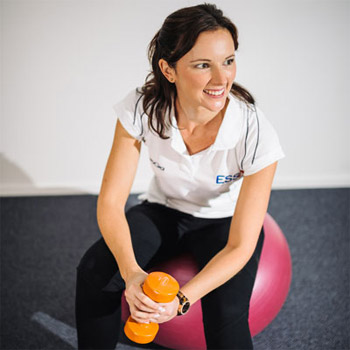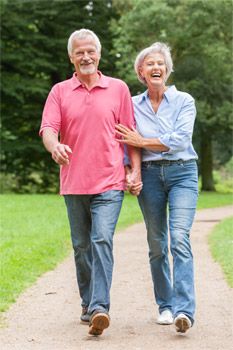Katie Lyndon Want To Make Your Partner Healthy Interview

Katie Lyndon Want To Make Your Partner Healthy Interview
Exercise & Sports Science Australia is setting the challenge to loved-up couples around Australia: if you want to help your partner live a longer, healthier life, then start moving yourself!
New research from the Johns Hopkins Bloomberg School of Public Health has found that if one half of a couple improves their exercise levels, the other half is more likely to follow suit.
'In Australia, almost 70 percent of the population are deemed as not sufficiently active and this figure continues to grow and affect the nation's health. We all know we should move more, but the reality is we just aren't," explains Accredited Exercise Physiologist, Katie Lyndon.
'This study interviewed over 3,261 couples about their physical activity levels over a period of six years. Of the people they interviewed only 45% percent of husbands and 33% of wives in the study group met the national recommendations for weekly exercise."
The results showed that when a wife met recommended levels of exercise at the first visit, her husband was 70 percent more likely to meet those levels at subsequent visits than those whose wives were less physically active. When a husband met recommended exercise levels, his wife was 40 percent more likely to meet the levels at follow-up visits.
'What this reveals to us is that one of the key components to maintaining an active lifestyle is to have the support of your partner. We are not just talking about moral support we mean, both of you have to get out there and get moving!"
'Exercising with your partner should be fun so try and think outside the square when it comes to exercise, try new activities that will challenge you both and help your overall health and who knows, it might improve your love life!" says Katie.
'It's also important to remember to exercise the right way for your needs, if you have an existing health condition or are worried about starting a new exercise regime then talk to your local GP or an accredited exercise physiologist who can give you the expert advice on how to get started."
Interview with Katie Lyndon; Senior Industry Development Officer (BAppSc(HMS) (Hons), AEP, Adv Dip Mgmt)
Exercise & Sports Science Australia (ESSA)
Question: What surprised you about this research out of Johns Hopkins Bloomberg School of Public Health?
Katie Lyndon: New research from the Johns Hopkins Bloomberg School of Public Health has found that if one half of a couple improves their exercise levels, the other half is more likely to follow suit. This research reconfirms our thoughts that social support plays a key role in the motivation for engaging in physical activity.
Question: What if we are quite active and our partners don't share the same motivation?
Katie Lyndon: In Australia, almost 70 percent of the population are deemed as not sufficiently active, so it is not uncommon for at least one person within a couple to not meet their daily physical activity needs. If your partner is struggling with motivation it is important that you provide positive support and encouragement to help them incorporate more physical activity into their day and congratulate them when they take the initiate to engage in exercise.
Exercising with your partner should be fun so try and think outside the square when it comes to exercise. Initiate opportunities for more movement such as starting an afternoon ritual of a -walk and talk' after work or taking your children to the park and moving with them rather than sitting as a spectator. Trying activities you can participate in together (such as hiking in the great outdoors or racket sports) also helps increase the enjoyment of exercise participation. Simple changes such as these can become a positive daily habit that will achieve long term health benefits for you both.
 Question: Why is it easier to exercise with a partner?
Question: Why is it easier to exercise with a partner?
Katie Lyndon: Research has shown us that social support provided by family members and friends play a key role in a person starting and maintaining an exercise program. Exercising with your partner can distract you from the task at hand, increasing your enjoyment and the fun of physical activity. Importantly, this provides valuable and high quality bonding time with your partner (rather than being zoned out in front of the television together every night) which will help to strengthen your relationship and enhance your happiness and energy levels.
Setting a joint -movement goal' to pursue and achieve together can provide a great sense of motivation and feelings of accomplishment, for example, achieving a certain amount of minutes walking per week, entering in a charity fun run or trying a new activity together.
Question: How can we support our partner in conducting regular exercise?
Katie Lyndon: Remember, knowledge is power – have a discussion with your partner about the relationship between physical activity and health, where research demonstrates that a lack of physical activity is strongly linked with chronic diseases such as diabetes, cancer, heart disease and mental illness. In fact, physical inactivity is the second greatest contributor, behind tobacco smoking, to the cancer burden in Australia.
Focus on the -why' behind your desire to be healthier – often this includes reasons such as being fit enough to look after and play with your children and/or grandchildren, living a long life together with your partner, maintaining your independence, and of course, being the best version of you so that you can offer the best version of you to your family and loved ones.
It is also important to remember to exercise the right way for your needs, if you have an existing health condition or are worried about starting a new exercise regime then talk to your local GP or an accredited exercise physiologist (AEP) who can give you the expert advice on how to get started.
Question: How often should adults exercise?
Katie Lyndon: The Australian Physical Activity Guidelines recommend that adults accumulate 150 to 300 minutes of moderate intensity physical activity or 75 to 150 minutes of vigorous intensity physical activity, or an equivalent combination of both moderate and vigorous activities, each week. Adults are also encouraged to do muscle strengthening activities at least 2 days each week and minimise the amount of time spent in prolonged sitting. These recommendations can seem overwhelming at first to somebody who engages in little or no exercise, however it is important to remember that something is better than nothing.
Question: Why are goals important to exercise progress?
Katie Lyndon: Goals can help keep you focussed and accountable – without setting goals for your exercise progress, engaging in physical activity may seem pointless or monotonous to you. Setting specific, measurable, achievable, realistic goals with a defined time frame (SMART goals) will enhance your motivation and sense of accomplishment and pride when you do achieve your targets. Don't give up if you don't initially achieve what you set out for, rather reassess your goals (perhaps break them down into smaller goals) and identify and overcome what may be barriers to achieving these goals. Remember, you don't have to be an athlete to achieve the many health benefits of exercise – simply walking and standing more throughout your day can help you lead a healthier, longer and happier life.
Question: What are your top five ways to move with your partner?
2. Hiking: Our country is blessed with thousands of national parks and well mapped walking paths that are there waiting to be enjoyed. Why not make it a date and head off into nature with a compass, good walking shoes and a picnic to celebrate.
3. Rock Climbing: Indoor rock climbing is an excellent way to improve your strength and fitness and also requires the input of your partner. Whilst one of you is climbing the other belays the ropes.
4. Kayaking: With 35,000kms of Australian coastline, getting your hands on a double kayak is an excellent way to improve your cardiovascular fitness and strength whilst enjoying the natural beauty of the sea.
5. Long walks on the beach: Not being ironic – it's true! If sports is not your thing, just making the time to enjoy exercise for 30 minutes a day with your partner will add years to your life.
Interview by Brooke Hunter
MORE



